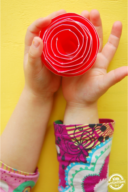Looks can be deceiving. This box might look small but it holds a whole afternoon of science experiments your kids will love.
It is a DIY Science Kit that has three different experiments in it and you can make it and gift it using items you most likely have lying about the house!
Kids Science Kit
Supplies you will need:
- 3 glass ornaments
- 2 corks
- Hydrogen Peroxcide
- White Vinegar
- Baking Soda
- Yeast
- 1 Balloon
- Clothespin and baggies
- Food Dye (optional, but adds a wow-factor)
- Marshmallows
- Raisins
- Can of Soda (any flavor)
With those items your kids can do three different experiments.
Baking Soda Experiment
We first did this chemical reactions baking soda experiment with a glove. That was eerie-cool!
With this experiment you will want to put a couple of tablespoons of baking soda into the balloon. We used a small rainbow loom band to keep the baking-soda filled balloon closed. You don’t want it spilling around your box before your kids can explore.
Remove the ornament “topper” and fill it 2/3rds full with white vinegar. If you are not doing the experiment now (i.e. putting it into the gift kit), put a cork firmly into the top of the ornament so the contents don’t leak out.
How to do this experiment:
Remove the rubber band from the balloon and the cork from the top of the ornament. Stretch the mouth of the balloon over the opening in the ornament. Make sure it is snug. Then gently dump the contents of the balloon, the baking soda, into the ornament. Lightly swirl the liquid and watch. The two chemicals (vinegar which is acid and baking soda which is base) will mix and cause a gaseous reaction. You can see this reaction happen – the balloon will begin to fill with air. Oh, the things you can do with vinegar and baking soda!
Nifty!
Elephant Toothpaste
sorta…in a bottle! I love elephant tooth paste – this is not true “toothpaste” – we modified the ingredients slightly so there would be less mess.
Remove the ornament “topper”. Fill the glass ornament with the hydrogen peroxide – you will want it to be slightly more than 1/2 full. Add food dye to the peroxide to make the results more evident. If you are gifting this experiment, You will want to both cork the bottle and keep it at the bottom of your box. Light will cause the hydrogen peroxide to break down making the experiment fail. Include a baggie with 1 rounded teaspoon of yeast.
To do this experiment kids will need to pour a tiny, tiny bit of water into the yeast packet.
Mix the baggie by hand and then dump the contents into your glass ornament. Swish the liquid in the ornament together and sit back and watch. Soon bubbles of oxygen will be released as the yeast causes the hydrogen peroxide to break down at a more rapid rate – so you see the bubbles forming as it escapes the bottle.
If you want to see the effect more “pronounced”, consider adding a couple of drops of dish detergent to the ornament with the hydrogenperoxide.
The soap will help trap the air as it escapes so you will see more bubbles.
Carbon Dioxide in Soda
We all feel the bubbles on our tongue while we drink soda. Those bubbles are carbon dioxide. This science experiment is a spin-off from the experiment we did making raisins dance. We will watch carbon dioxide molecules form.
If you are gifting this as a kit, give your kids a can of soda, a baggie of marshmallows and a baggie of raisins. You can use ANY type of soda for this experiment, but looking at the photos, I think the result would be more colorful and effective if we used Mountain Dew or another light colored fizzy beverage.
To do the experiment, pour the soda into the bottle. You will want to fill it 2/3rds full. Smash the marshmallows so they are roughly the size of the raisins and stuff a couple into the bottle. What happens? Do the experiment again only use raisins this time (you can put 3-4 of them into the bottle). What happens? The carbon dioxide molecules were attracted to the rough mostly-nonporous surface of the raisins, and it lifted the raisins with the bubbles it formed. The marshmallow did not work. Ask your kids why they think it failed.
Science Fun
Keep reading. We have more science experiments for kids!



























Hello,I read your new stuff named “Totally Awesome Kids Science Kit {You can make it!!}” on a regular basis.Your writing style is witty, keep up the good work! And you can look our website about ????? ?????.